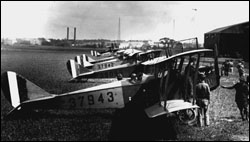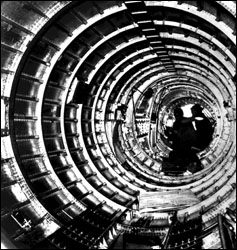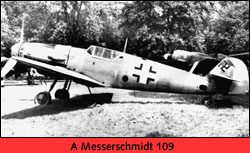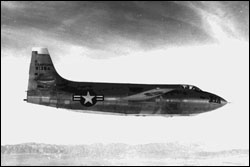
|

|

|
Secret History
 Dr. Richard P. Hallion is The Air Force Historian for
the United States Air Force. Previously, Dr. Hallion was
curator of science and technology at the Smithsonian
Institution. NOVA spoke with him on the eve of the 50th
anniversary of the breaking of the sound barrier.
Dr. Richard P. Hallion is The Air Force Historian for
the United States Air Force. Previously, Dr. Hallion was
curator of science and technology at the Smithsonian
Institution. NOVA spoke with him on the eve of the 50th
anniversary of the breaking of the sound barrier.
NOVA: How early on did the Americans get involved in
pursuing high-speed flight?
HALLION: The American experience in high speed flight
is quite interesting. In the 1920s and '30s, what we often
term as the Golden Age of Aviation we saw radical
transformations in aircraft design. We went from the era of
the wooden airplane to the all-metal airplane. We went from
the era of the biplane to the
 era of the monoplane. We went from the era of relatively
crude propulsion technology to the era of very reliable
engine combinations. We went from an era in which people did
not use the airplane for commercial purposes to an era by
the early 1940s in which commercial aviation was very
widespread. So this is a radically transforming time in
aviation. In the 1920s, a great number of researchers
started looking at the problems of flow around propellers,
because propeller tips were beginning to approach the speed
of sound as the propeller rotated. A propeller is, after
all, a rotating wing. And the connection was made in the
minds of researchers that if a propeller encounters
disturbing flow conditions at high speeds, then obviously at
high speeds the wing of an airplane would as well.
era of the monoplane. We went from the era of relatively
crude propulsion technology to the era of very reliable
engine combinations. We went from an era in which people did
not use the airplane for commercial purposes to an era by
the early 1940s in which commercial aviation was very
widespread. So this is a radically transforming time in
aviation. In the 1920s, a great number of researchers
started looking at the problems of flow around propellers,
because propeller tips were beginning to approach the speed
of sound as the propeller rotated. A propeller is, after
all, a rotating wing. And the connection was made in the
minds of researchers that if a propeller encounters
disturbing flow conditions at high speeds, then obviously at
high speeds the wing of an airplane would as well.
NOVA: Was the quest to break the sound barrier
initially motivated by possible military applications?
 HALLION: Absolutely not. In fact, in the early 1930s
the initial thought on this was that this will improve the
effectiveness of commercial aircraft. They will be able to
operate at higher altitudes and speeds. At higher altitude,
where your density is less, you can fly further or the same
amount of energy, therefore, they will be more fuel
efficient and they will be more payload efficient. And those
are strictly commercial questions. Now you can turn them
around and say, well, if you can carry greater payload and
you can carry it more effectively that payload may be
airmail or it may be bombs. So there's a military issue here
obviously as well. But people, at least in the 1930s, were
thinking less of military applications than commercial
applications.
HALLION: Absolutely not. In fact, in the early 1930s
the initial thought on this was that this will improve the
effectiveness of commercial aircraft. They will be able to
operate at higher altitudes and speeds. At higher altitude,
where your density is less, you can fly further or the same
amount of energy, therefore, they will be more fuel
efficient and they will be more payload efficient. And those
are strictly commercial questions. Now you can turn them
around and say, well, if you can carry greater payload and
you can carry it more effectively that payload may be
airmail or it may be bombs. So there's a military issue here
obviously as well. But people, at least in the 1930s, were
thinking less of military applications than commercial
applications.
NOVA: At some point countries around the world began
working in earnest on the problem of breaking the sound
barrier. What prompted that stepped-up interest?
HALLION: The whole problem of high speed flight was
of relatively academic interest until the mid 1930s. But in
the mid 1930s two developments occurred that made it much
more of a concern. First, we had the appearance of the jet
engine. That opened up to us the potential of practical high
speed flight. But the second event that occurred was the
beginning of a
 series of mysterious and indeed alarming accidents involving
high speed airplanes. And this started in 1937 with the
accident of a experimental German fighter, a new German
fighter in service, the Messerschmidt 109, which clearly
came apart in flight because the pilot had experienced some
major problem with aircraft control as he dove to higher and
higher speeds. Very quickly those problems started to appear
on other high performance military airplanes in the other
nations of the world. Obviously what we were dealing here
with was an international challenge; we're no longer
confronting merely a barrier in the mind or a barrier that's
a theoretical construct. Now we were seeing it as an actual
physical barrier that would have to be overcome.
series of mysterious and indeed alarming accidents involving
high speed airplanes. And this started in 1937 with the
accident of a experimental German fighter, a new German
fighter in service, the Messerschmidt 109, which clearly
came apart in flight because the pilot had experienced some
major problem with aircraft control as he dove to higher and
higher speeds. Very quickly those problems started to appear
on other high performance military airplanes in the other
nations of the world. Obviously what we were dealing here
with was an international challenge; we're no longer
confronting merely a barrier in the mind or a barrier that's
a theoretical construct. Now we were seeing it as an actual
physical barrier that would have to be overcome.
NOVA: The obstacles to breaking the sound barrier
were the aircraft design itself and the building of a
propulsion capable of pushing a plane that fast. Would you
say that those were equal challenges?
HALLION: The propulsion challenge was not one that
was as limiting as the aerodynamic challenge. The propulsion
challenge was resolved by the development of the jet engine,
and also by the availability of the rocket engine. And it
was a matter from that point on of merely growing the
maturity of those two systems. The real challenge, because
there were many unknowns, and many grave difficulties, was
the aerodynamic challenge—what actually happens to an
airplane as it approaches closer and closer and hopefully
eventually passes through the speed of sound. The flow
conditions around the airplane change completely. It catches
up in flight with its own pressure signals that are
descending ahead of it, so to speak. It's like a ship
catching up with its own bow wave and then passing through
it. As a result of this, there was a very great interest in
studying the phenomena of what was called trans-sonic
flight—flight between the sub-sonic and super-sonic
region. (See
Sonic Boom)
NOVA: How did researchers go about investigating
trans-sonic flight in those early days?
HALLION: The traditional tool for that was the wind
tunnel. Unfortunately, wind tunnel technology at that time
did not predict accurate and reliable measurement of flow
conditions around aircraft at speeds in the region of the
speed of sound. This was so because models in a wind tunnel
would be exposed to air flow that would generate shock
waves. These shock waves would reverberate and reflect
across the test section of the tunnel and all subsequent
measurements would be largely invalid. So there was a
sizable gap that ran from approximately 75 percent of the
speed of sound—what we refer to as mach .75—to
about 1.25 times the speed of sound that was really an area
that needed to be explored and understood. And it was to
research that area that the British government and the
United States government and indeed other countries as well,
pursued the development of specialized research airplanes
that would be instrumented to record and take data on flow
conditions at those speeds. In effect these airplanes were
to be research tools using the sky as a laboratory.
NOVA: In what ways did the success of the X-1 program
give us an edge over other countries? (See
Men of the X-1)
HALLION: The X-1 program, first of all, demonstrated
that with appropriate design technology one could design a
airplane that could pass through the speed of sound and not
merely survive but be fully functional and fully
controllable while doing so. Chiefly it demonstrated the
following: that one needed to have a very smooth body shape,
what we call a relatively high fineness ratio fuselage, a
body that is long and slender. It's interesting that we saw
that because if we look at the X-1 now, it has almost a
pudgy look, if you will, compared to modern high performance
airplanes. But for its time it was radically streamlined. It
was based after all on the shape of a bullet. The other
lesson that came out of the X-1 was that high performance
wing design should emphasize thin wings that have what we
call relatively low aspect ratios. In other words, the wings
should be fairly short and thin. That enables you to fly
faster and more effectively. Another design element that
came out of the X-1 was that you needed to have large fully
controllable tail surfaces. The ability to maneuver the
entire tail surface of the X-1 played a key role in getting
the X-1 through the speed of sound safely and
controllably.
 NOVA: At the time of the X-1 program, were there
concerns that other countries were spying on us?
NOVA: At the time of the X-1 program, were there
concerns that other countries were spying on us?
HALLION: During the second World War, even as the war
was going on, we were already seeing some of the hallmarks
of the Cold War. Namely we were seeing espionage directed
against the United States by the Soviet Union, and we were
seeing a counter-intelligence effort by the United States to
try to find out what the Soviets were up to in terms of what
they were trying to learn about us. So during the second
World War we had the beginnings of a program that had some
tremendous significance. It was called Venona, and it began
in February 1943. It was run by the U.S. Army's Signal
Intelligence Service. That's a forerunner of the present day
National Security Agency. The purpose of Venona was to
examine and possibly exploit encrypted Soviet diplomatic
communications. Many messages were accumulated by the Venona
team, but because these were encrypted it was very, very
difficult to translate them. And many of the wartime
messages were in point of fact not translated until after
the war. From our translation activities of Soviet
communications we learned that there was a very active
effort by the Soviets to collect information on the United
States.
NOVA: So we didn't find out about the Soviet
espionage until after the war?
HALLION: Because of the volume and the nature of the
traffic, many of these messages were not able to be broken
until after the second World War, simply because the process
of breaking them was so difficult. They were all encrypted
in a cipher system. We had to break the cipher systems, and
we had to find the keys in order to break those. Now what
was very interesting, as we found out later, was that there
were a number of people in various key government
organizations that were targeted by the Soviets to be
sources of information or who in fact, were themselves
Soviet agents. One of these was an individual working in the
National Advisory Committee for Aeronautics. His name was
William Perl. William Perl was part of a spy ring
established by Julius Rosenberg. Now the Rosenberg spy ring
has always been thought of primarily as an atomic espionage
ring. But in point of fact in its early years it was
targeting the aeronautical industry and the electronics
industry. As early as 1943, Perl was passing information to
the Soviets on jet engine design. Perl later joined the
Louis Research Center of the NACA, now NASA, and while there
was engaged in the design of supersonic wind tunnel
facilities, consulting on engine development and also did a
lot of work related to the atomic airplane program. So Perl
was a very highly placed source of information for the
Soviets and was transmitting a great deal of information to
them.
NOVA: How did the Soviets benefit from this
information?
HALLION: There's a technology transfer that you see
very clearly. The Mig fighter family is the classic example
to use. If you take a look at when the designs of the Mig 15
and 17 are actually fixed (and they're developed in the
immediate post World War II era) I think that the Soviets
were not able to get the information that they needed in
time to make those aircraft what they could have been.
Instead where we see this [espionage] material radically
transform Soviet military aviation is in the next generation
of Mig aircraft, the Mig 19. The Mig 19 is the first Soviet
supersonic jet fighter. It appears contemporaneously with
the first American supersonic jet fighter, the F-100. They
both appear in 1953. They both have roughly the same
performance capabilities. In fact, one could argue that the
Mig 19 actually had a slightly higher performance. And so
what this shows is the gap closed.
NOVA: What was Britain's relationship with the Soviet
Union during and after the war?
HALLION: Britain's relationship with the Soviets in
the 1940s was a very interesting one. At the same time that
we see Winston Churchill giving us the Iron Curtain
metaphor, and we start seeing the emergence of the Cold War,
we see the British government willy nilly selling high
technology to the Soviets. And the classic example of what
they sold were two high performance jet engines, the Rolls
Royce Durwent and the Rolls Royce Nene. And the Nene engine,
interestingly enough, in Korea, powered not only the Mig 15,
but it also powered some of the American Airplanes (because
it had been sold to the United States in license built form)
that we were using against the Mig 15. For example, in
Korea, in November, 1950, a U.S. Navy fighter airplane
called the F 9 F Panther confronted the first production
Soviet Mig 15's that were being flown in Korea—the two
airplanes were flying using essentially the same engine. You
could have interchanged the engines in these airplanes.
NOVA: Looking to the future, is it safe to say that
the ability to fly faster than sound is, as far as modern
military aircraft are concerned, a necessity?
HALLION: It's a sine quo non. It is absolutely
critical. Supersonic flight, which has been very important
to us in engagement since we first became a supersonic
force, is as important now as it has ever been. Indeed, I
would argue it is more important now. For rapid response,
for getting into a hostile area and getting out, and for
achieving military effects quickly, nothing beats supersonic
speed. Indeed the tendency ultimately within the next 30
years will be for hypersonic speed.
NOVA: Define hypersonic.
HALLION: Moving on the order of five times the speed
of sound. Now you may not be doing this with a piloted
system or you may be using a supersonic airplane firing
hypersonic weapons, but engagement now in the terminal arena
where that engagement takes place—I think we will see
engagement eventually moving into the hypersonic arena very,
very quickly. Extremely quickly.
Photos: (1) U.S. Air Force; (2-3) UPI/Corbis-Bettmann;
(4) Corbis-Bettmann; (5) Bell Helicopter Textron Inc.
Men of the X-1 |
Secret History |
Sonic Boom |
Speed Machines
Resources |
Teacher's Guide
|
Transcript
|
Faster Home
Editor's Picks
|
Previous Sites
|
Join Us/E-mail
|
TV/Web Schedule
About NOVA |
Teachers |
Site Map |
Shop |
Jobs |
Search |
To print
PBS Online |
NOVA Online |
WGBH
©
| Updated October 2000
|
|
|

 Dr. Richard P. Hallion is The Air Force Historian for
the United States Air Force. Previously, Dr. Hallion was
curator of science and technology at the Smithsonian
Institution. NOVA spoke with him on the eve of the 50th
anniversary of the breaking of the sound barrier.
Dr. Richard P. Hallion is The Air Force Historian for
the United States Air Force. Previously, Dr. Hallion was
curator of science and technology at the Smithsonian
Institution. NOVA spoke with him on the eve of the 50th
anniversary of the breaking of the sound barrier. era of the monoplane. We went from the era of relatively
crude propulsion technology to the era of very reliable
engine combinations. We went from an era in which people did
not use the airplane for commercial purposes to an era by
the early 1940s in which commercial aviation was very
widespread. So this is a radically transforming time in
aviation. In the 1920s, a great number of researchers
started looking at the problems of flow around propellers,
because propeller tips were beginning to approach the speed
of sound as the propeller rotated. A propeller is, after
all, a rotating wing. And the connection was made in the
minds of researchers that if a propeller encounters
disturbing flow conditions at high speeds, then obviously at
high speeds the wing of an airplane would as well.
era of the monoplane. We went from the era of relatively
crude propulsion technology to the era of very reliable
engine combinations. We went from an era in which people did
not use the airplane for commercial purposes to an era by
the early 1940s in which commercial aviation was very
widespread. So this is a radically transforming time in
aviation. In the 1920s, a great number of researchers
started looking at the problems of flow around propellers,
because propeller tips were beginning to approach the speed
of sound as the propeller rotated. A propeller is, after
all, a rotating wing. And the connection was made in the
minds of researchers that if a propeller encounters
disturbing flow conditions at high speeds, then obviously at
high speeds the wing of an airplane would as well. HALLION: Absolutely not. In fact, in the early 1930s
the initial thought on this was that this will improve the
effectiveness of commercial aircraft. They will be able to
operate at higher altitudes and speeds. At higher altitude,
where your density is less, you can fly further or the same
amount of energy, therefore, they will be more fuel
efficient and they will be more payload efficient. And those
are strictly commercial questions. Now you can turn them
around and say, well, if you can carry greater payload and
you can carry it more effectively that payload may be
airmail or it may be bombs. So there's a military issue here
obviously as well. But people, at least in the 1930s, were
thinking less of military applications than commercial
applications.
HALLION: Absolutely not. In fact, in the early 1930s
the initial thought on this was that this will improve the
effectiveness of commercial aircraft. They will be able to
operate at higher altitudes and speeds. At higher altitude,
where your density is less, you can fly further or the same
amount of energy, therefore, they will be more fuel
efficient and they will be more payload efficient. And those
are strictly commercial questions. Now you can turn them
around and say, well, if you can carry greater payload and
you can carry it more effectively that payload may be
airmail or it may be bombs. So there's a military issue here
obviously as well. But people, at least in the 1930s, were
thinking less of military applications than commercial
applications. series of mysterious and indeed alarming accidents involving
high speed airplanes. And this started in 1937 with the
accident of a experimental German fighter, a new German
fighter in service, the Messerschmidt 109, which clearly
came apart in flight because the pilot had experienced some
major problem with aircraft control as he dove to higher and
higher speeds. Very quickly those problems started to appear
on other high performance military airplanes in the other
nations of the world. Obviously what we were dealing here
with was an international challenge; we're no longer
confronting merely a barrier in the mind or a barrier that's
a theoretical construct. Now we were seeing it as an actual
physical barrier that would have to be overcome.
series of mysterious and indeed alarming accidents involving
high speed airplanes. And this started in 1937 with the
accident of a experimental German fighter, a new German
fighter in service, the Messerschmidt 109, which clearly
came apart in flight because the pilot had experienced some
major problem with aircraft control as he dove to higher and
higher speeds. Very quickly those problems started to appear
on other high performance military airplanes in the other
nations of the world. Obviously what we were dealing here
with was an international challenge; we're no longer
confronting merely a barrier in the mind or a barrier that's
a theoretical construct. Now we were seeing it as an actual
physical barrier that would have to be overcome. NOVA: At the time of the X-1 program, were there
concerns that other countries were spying on us?
NOVA: At the time of the X-1 program, were there
concerns that other countries were spying on us?